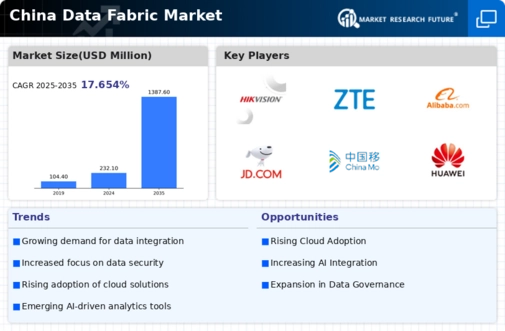Expansion of IoT Ecosystem
The proliferation of Internet of Things (IoT) devices in China significantly influences the data fabric market. With millions of devices generating vast amounts of data, organizations face challenges in managing and integrating this information effectively. The data fabric market provides solutions that enable seamless connectivity and data management across diverse IoT ecosystems. As of 2025, it is estimated that the number of connected IoT devices in China will exceed 1 billion, creating an urgent need for robust data management frameworks. This expansion not only drives demand for data fabric solutions but also encourages innovation in data integration technologies, as businesses strive to harness the potential of IoT data for enhanced operational efficiency.
Growing Focus on Data Governance
In the context of the data fabric market, the emphasis on data governance in China is becoming increasingly pronounced. Organizations are recognizing the necessity of establishing robust data governance frameworks to ensure compliance with regulations and to enhance data quality. As data privacy concerns rise, particularly with the implementation of stricter data protection laws, businesses are compelled to adopt solutions that facilitate effective data management and governance. It is estimated that by 2025, over 70% of enterprises in China will prioritize data governance as a critical component of their data strategy. This shift is likely to drive demand for data fabric solutions that offer comprehensive governance capabilities, thereby enhancing the overall integrity and security of data assets.
Increased Investment in Data Analytics
The data fabric market in China is poised for growth due to the escalating investment in data analytics across various sectors. Organizations are increasingly recognizing the value of data-driven insights in enhancing operational efficiency and driving innovation. As a result, spending on data analytics tools and technologies is projected to reach $50 billion by 2025. This investment trend is likely to create a ripple effect, as businesses seek to implement data fabric solutions that facilitate the integration and analysis of diverse data sources. The ability to derive actionable insights from data is becoming a competitive necessity, thereby propelling the demand for data fabric solutions that support advanced analytics capabilities.
Rising Demand for Real-Time Data Processing
The data fabric market in China experiences a notable surge in demand for real-time data processing capabilities. As businesses increasingly rely on timely insights to drive decision-making, the need for efficient data integration and management solutions becomes paramount. This trend is particularly evident in sectors such as finance and e-commerce, where the ability to analyze data in real-time can lead to competitive advantages. According to recent estimates, the market for real-time data processing solutions is projected to grow at a CAGR of approximately 25% over the next five years. This growth is likely to propel the data fabric market, as organizations seek to implement architectures that support seamless data flow and accessibility across various platforms.
Government Initiatives for Digital Transformation
The Chinese government actively promotes digital transformation across various industries, which has a profound impact on the data fabric market. Initiatives aimed at enhancing data infrastructure and encouraging the adoption of advanced technologies are likely to create a favorable environment for data fabric solutions. For instance, the 'Digital China' strategy emphasizes the importance of data-driven decision-making and the integration of digital technologies in traditional sectors. This governmental push is expected to result in increased investments in data management solutions, with projections indicating that spending on digital transformation initiatives could reach $300 billion by 2025. Consequently, the data fabric market stands to benefit from these initiatives as organizations seek to align with national objectives.






















Leave a Comment